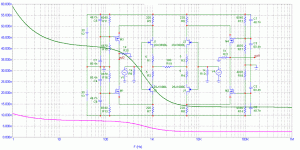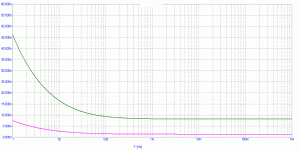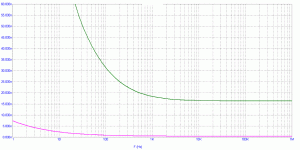PMA said:How about compensated feedback divider
R1//C1 + R2//C2
Put in values that work and your getting close.
john curl said:This is not the quietest circuit in the world, because the mosfets on the output will contribute significant 1/f noise. This can be fixed, but the solution is worse than the problem, except for a slight noise improvement.
John/PMA,
In PMA's schematic in post #4315, do the resistors used to reference the Gates in the folded cascode influence the quantity/spectral distribution of the noise in any way? Same question for bipolars. Given the higher noise inherent in larger values of resistance, it seems that it might be worth choosing lower values of resistance, albeit at the cost of slightly greater current draw for the circuit overall. Alternatively you could bypass with a cap from Gate to ground to short some of the noise. I'm not suggesting a day and night difference...just one of those tweaks that would make an incremental improvement.
Grey
Grey,
IMHO that is why Scott came with the issue.
They do, and capacitive divider in parallel would work.
IMHO that is why Scott came with the issue.
They do, and capacitive divider in parallel would work.
scott wurcer said:
Put in values that work and your getting close.
Small damping resistors in series with caps needed?
I might suggest starting from the original and replacing the (4) 220 ohm resistors with noiseless current sources of the same current flow.
john curl said:I might suggest starting from the original and replacing the (4) 220 ohm resistors with noiseless current sources of the same current flow.
PMA said:It works:
 Need he say more?
Need he say more?Re: Noise Analysis
Pavel,
Schematic looks very familiar, especially the gate resistor values of the output Mosfets 😀
However, very informative postings.
Take care 😉
Pavel,
Schematic looks very familiar, especially the gate resistor values of the output Mosfets 😀
However, very informative postings.
Take care 😉
The second major noise source that can be fixed, is the feedback resistor. If you reduce its size,
input noise will drop significantly. So, a gain of 10 stage is quieter than a gain of 4 stage.
input noise will drop significantly. So, a gain of 10 stage is quieter than a gain of 4 stage.
I can tell you that Spice or MC is really a powerfull tool. A colleague of mine visited me 3 days ago with his newly designed power amp. He had stability issues. We measured the amp with fast rise square (10ns rise time) and scope, and seen problems. The amp was not a simple structure. We made an MC circuit and got exactly same time responses vs. variable amplitude, as seen on scope screen. Then we tuned compensation caps in MC to fix the problem. Just found the caps that mattered. And it worked. Though I knew MC capabilities, I was quite surprised.
PMA I can say, equally, that not using Spice, but understanding low noise, low distortion audio design is also very powerful. I had these answers before you put it into SPICE, just from cut and try, and understanding noise contributions. Still, Spice is OK, and VERY useful to someone, like you, who can make it work properly.
I've split the "The Death of High Fidelity" to:
http://www.diyaudio.com/forums/showthread.php?threadid=122023
/Hugo
http://www.diyaudio.com/forums/showthread.php?threadid=122023
/Hugo
- Status
- Not open for further replies.
- Home
- Amplifiers
- Solid State
- John Curl's Blowtorch preamplifier




